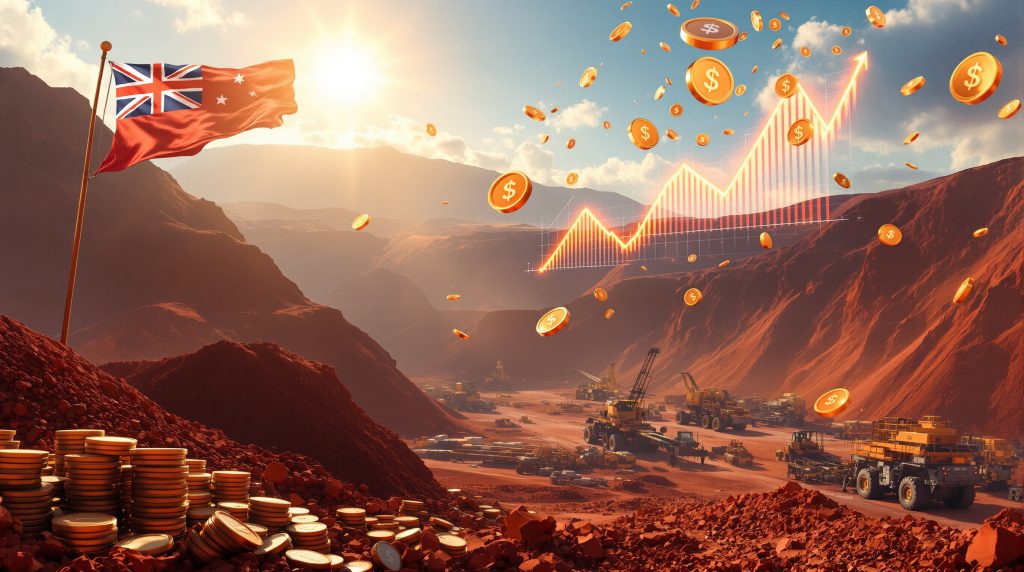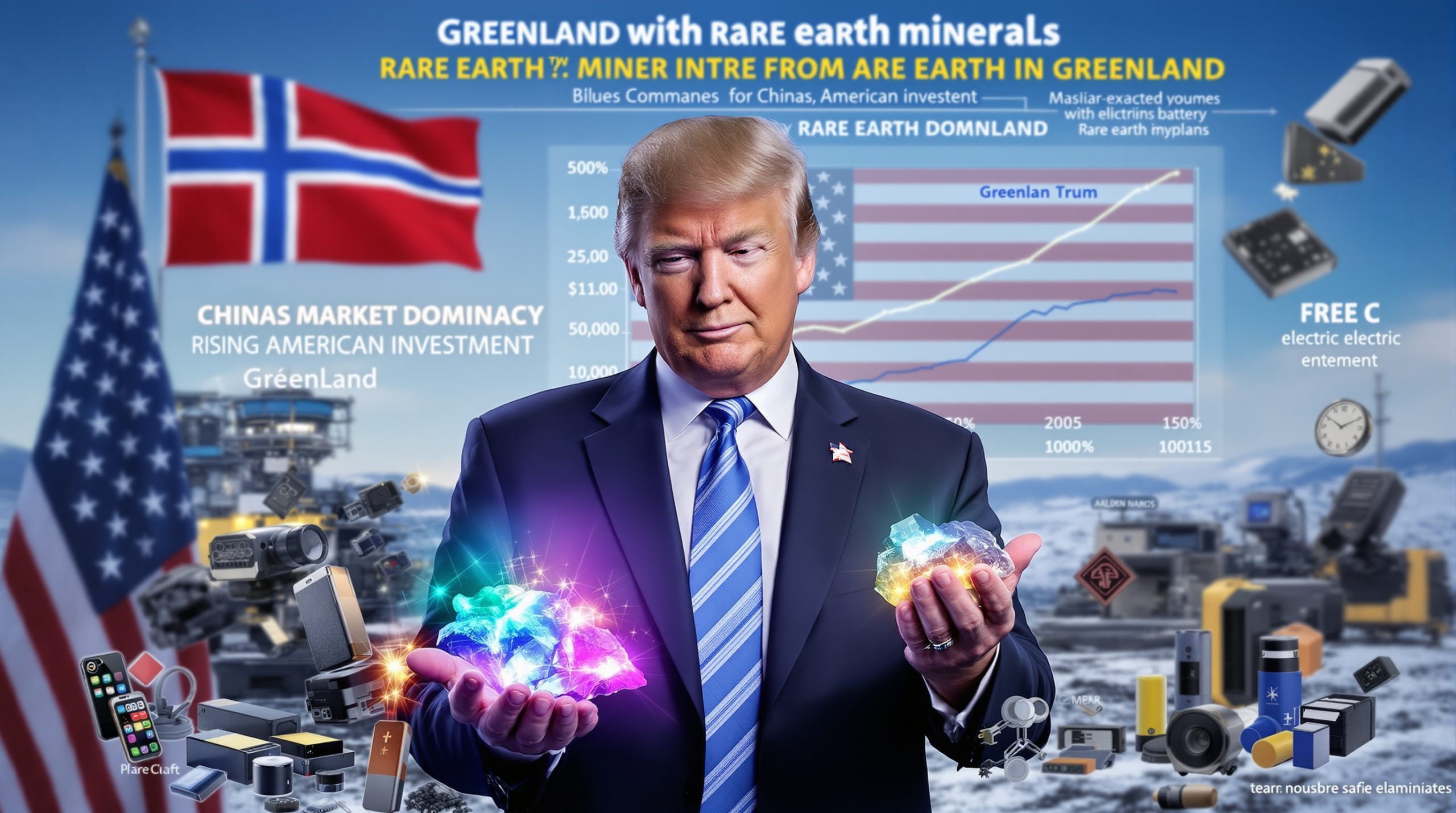What Makes Rio Tinto Shares Attractive Despite Recent Gains?
The Rio Tinto share price has shown impressive momentum in recent months, with September 2025 alone delivering a 5.7% increase. This positive trend has continued despite the mining giant already experiencing approximately 5% growth since the beginning of 2025. Currently valued at a market capitalization of $46 billion, Rio Tinto presents a compelling investment case for those looking to add resource sector exposure to their portfolios.
Professional investors, particularly fund managers at WAM Leaders, have positioned Rio Tinto as one of their largest overweight holdings. Their analysis suggests the current share price "effectively assumes an iron ore price well below the current market price," indicating a potential disconnect between market valuation and operational reality.
As one of the world's most diversified miners, Rio Tinto's operations span critical commodities including iron ore trends, aluminum, copper, and various other minerals essential to global industrial production and the energy transition. This diversification provides natural insulation against market volatility strategies in any single commodity market, creating a more stable investment proposition compared to more narrowly focused competitors.
How Is Rio Tinto Benefiting From China's Shifting Trade Dynamics?
The Strategic Advantage of Chinese Trade Relationships
Recent developments in China's resource procurement strategies have created a distinctly favorable environment for Rio Tinto's iron ore business. In a significant market shift, China Mineral Resources Group (CMRG), a major state-run iron ore purchaser, has reportedly restricted iron ore purchases from BHP Group, one of Rio Tinto's primary competitors.
This trade restriction has directly enhanced Rio Tinto's market position and pricing power. With China continuing to require substantial iron ore imports to feed its steel mills, the redirection of purchasing away from competitors naturally benefits alternative suppliers like Rio Tinto, potentially increasing both volume and pricing for their iron ore exports.
Market analysts note that Rio Tinto's relationship with Chinese authorities has strengthened at a critical time when geopolitical tensions have complicated tax and royalty analysis for some other Australian resource companies. This positioning could provide lasting advantages as China continues its infrastructure development and industrial production.
The Simandou Advantage in Chinese Relations
Rio Tinto's joint venture mining project in Simandou represents another critical element in its favorable positioning with Chinese authorities. This massive undertaking in Africa has fostered stronger relations between Rio Tinto and Chinese interests at a time when such relationships carry significant weight in global commodity markets.
The Simandou project's scale suggests it could meaningfully impact the global iron ore market once operational. Industry experts estimate the deposit contains some of the highest-grade iron ore reserves globally, which could potentially reshape market dynamics when production begins at scale.
This collaborative project provides Rio Tinto with a strategic advantage, particularly considering that Chinese policy decisions influence a substantial portion of global iron ore demand. The partnership demonstrates Rio Tinto's willingness to work collaboratively with Chinese interests on projects of mutual benefit, potentially insulating the company from trade tensions affecting other suppliers.
What Market Conditions Are Supporting Rio Tinto's Commodity Portfolio?
Supply Chain Disruptions Boosting Metal Prices
Beyond iron ore, Rio Tinto's diversified commodity portfolio continues to benefit from persistent supply chain challenges across the industrial metals sector. These disruptions have provided support for both aluminum and copper price insights, two significant revenue streams for the company.
The well-established pattern of supply constraints has created a favorable pricing environment that directly enhances Rio Tinto's profitability across multiple business segments. Industrial metals markets have experienced consistent supply shortfalls relative to demand, with logistical bottlenecks, energy constraints, and regulatory issues limiting new production capacity across global markets.
For aluminum, energy-intensive production processes have faced challenges from rising power costs in many regions, constraining supply growth while demand remains robust. Similarly, copper has seen limited new mine development while facing growing demand from electrification trends and renewable energy infrastructure.
Current Valuation Disconnect From Market Realities
According to fund managers at WAM Leaders, the current Rio Tinto share price "effectively assumes an iron ore price well below the current market price." This valuation disconnect suggests the market may be underestimating the company's near-term earnings potential based on prevailing commodity prices.
This perceived gap between market valuation and operational reality represents a potential opportunity for investors seeking exposure to the resources sector through a well-established, diversified mining company. The market appears to be pricing in a significant decline in iron ore prices that has not yet materialized, creating a potential value opportunity.
Investors who recognize this disconnect may benefit from the company's ability to generate substantial cash flows at current commodity price levels, potentially leading to strong shareholder returns through dividends and potential share price appreciation if commodity prices remain resilient.
How Has Rio Tinto's Share Price Performed in 2025?
Year-to-Date Performance Analysis
In 2025 to date, Rio Tinto shares have appreciated by approximately 5%, contributing to the company's current market capitalization of $46 billion. While this performance has been positive, it represents a relatively modest gain compared to the company's operational performance and the prevailing commodity price environment.
The September performance was particularly strong, with the share price rising 5.7% in a single month. This recent momentum suggests growing market recognition of the company's favorable positioning in key commodity markets and its strategic relationships with major customers.
When compared to broader market indices, Rio Tinto's performance demonstrates relative strength in an environment where many industrial companies have faced challenges from rising input costs and supply chain disruptions. The company's ability to benefit from these same disruptions through higher commodity prices has provided a competitive advantage.
Why Are Fund Managers Overweighting Rio Tinto?
Strategic Portfolio Positioning by Major Investors
Fund managers at WAM Leaders have positioned Rio Tinto as one of their largest overweight holdings relative to the broader market. This strategic allocation places Rio Tinto alongside other carefully selected companies including Orora, WiseTech Global, Challenger, and Iluka Resources.
Professional investors with deep market knowledge and research capabilities have expressed confidence in Rio Tinto's value proposition compared to other investment opportunities in the Australian market. Their positioning suggests a belief that the market is undervaluing Rio Tinto's current earnings power and future potential.
WAM Leaders focuses on identifying high-quality Australian companies with sustainable competitive advantages and favorable industry positioning. Their significant allocation to Rio Tinto indicates a strong conviction in the company's management, asset quality, and long-term strategic direction.
Competitive Advantage Over Sector Peers
Investment professionals continue to express a preference for Rio Tinto over competitors in the mining sector, citing the company's favorable positioning in key commodity markets and its strategic relationships with major customers. This competitive advantage provides Rio Tinto with a potentially more stable operating environment compared to some industry peers.
The company's diversified asset base, strong balance sheet, and operational excellence create a compelling investment case relative to more narrowly focused mining companies. Rio Tinto's scale and operational expertise allow it to weather market volatility more effectively than smaller competitors, while its diversity provides more stable cash flows than single-commodity producers.
What Are The Risks To Consider When Investing In Rio Tinto?
Commodity Price Volatility
While current commodity pricing trends favor Rio Tinto, investors should remain mindful of the inherent volatility in resource markets. Iron ore, aluminum, and copper prices can experience significant fluctuations based on global economic conditions, supply-demand balances, and geopolitical developments.
Historical commodity price cycles demonstrate that periods of high prices often lead to supply responses that eventually balance markets. If global economic growth slows significantly or new supply comes online faster than anticipated, commodity prices could decline from current levels, impacting Rio Tinto's profitability and share price performance.
Investors should consider the cyclical nature of commodity markets when establishing position sizes and investment timeframes, recognizing that even well-managed resource companies experience earnings volatility through market cycles.
Geopolitical Considerations
Rio Tinto's global operations expose the company to various geopolitical risks, including potential changes in trade policies, resource nationalism, and regulatory shifts in key operating jurisdictions. These factors could impact operational continuity and profitability.
The company's significant exposure to China as a key customer creates both opportunities and risks. While current trade dynamics favor Rio Tinto, any future deterioration in Australia-China relations could potentially impact demand for the company's products or lead to policy changes affecting pricing or market access.
Similarly, operations in diverse jurisdictions including Africa, South America, and various developed markets expose the company to potential regulatory changes, tax regime alterations, or political instability that could affect specific assets or projects.
Project Development Challenges
The successful development of major projects like Simandou carries execution risks related to timeline adherence, capital expenditure management, and achieving projected production targets. Any significant delays or cost overruns could impact investor sentiment.
Large-scale mining projects frequently face challenges including environmental permitting delays, infrastructure development complications, local community relations issues, or technical challenges in resource extraction. These factors can extend development timelines and increase capital requirements, potentially reducing project returns.
Investors should monitor the company's project execution track record and management commentary regarding development milestones for insights into potential risks or opportunities related to major growth initiatives.
Is Rio Tinto A Good Investment For Dividend Seekers?
Dividend Yield Considerations
Rio Tinto has historically maintained a strong focus on shareholder returns through dividends. The company's dividend policy is designed to provide meaningful income to investors while maintaining financial flexibility to navigate commodity price cycles.
During periods of strong commodity prices and resulting cash flow generation, Rio Tinto has demonstrated a willingness to return substantial capital to shareholders through both regular and special dividends. This approach has made the company attractive to income-focused investors seeking exposure to the resources sector.
When evaluating Rio Tinto's dividend potential, investors should consider both the base dividend level the company aims to maintain through cycles and the potential for additional returns during favorable market conditions, creating a potentially attractive total yield proposition.
Sustainability of Shareholder Returns
The company's diversified commodity exposure provides a degree of earnings stability that supports dividend sustainability. While dividend payments may fluctuate with commodity price cycles, Rio Tinto's strong balance sheet and operational cash flow generation capacity underpin its ability to maintain shareholder returns over the long term.
Management has demonstrated discipline in capital allocation, balancing growth investments, debt management, and shareholder returns based on prevailing market conditions. This balanced approach suggests the company can maintain appropriate dividend coverage through market cycles while preserving financial flexibility.
Investors focused on long-term income generation should consider Rio Tinto's dividend history through previous commodity cycles for insights into management's commitment to maintaining returns during challenging market conditions.
How Does Rio Tinto's Valuation Compare To Historical Averages?
Current Valuation Metrics
When examining Rio Tinto's valuation relative to its historical trading ranges, current metrics suggest the company is trading below long-term averages on several key measures. This discount to historical valuation norms provides additional support for the undervaluation thesis.
Traditional valuation metrics including price-to-earnings ratios, enterprise value to EBITDA multiples, and price-to-book value comparisons all indicate potential undervaluation when compared to historical trading ranges. This valuation compression likely reflects market concerns about future commodity price sustainability rather than current operational performance.
The apparent disconnect between current profitability and market valuation creates a potential opportunity for investors willing to take a contrarian view on commodity price sustainability or those with longer investment horizons who can weather potential near-term volatility.
Forward-Looking Valuation Considerations
Looking ahead, Rio Tinto's valuation appears particularly attractive when considering its growth initiatives and strategic positioning in commodities essential to global infrastructure development and the energy transition. These forward-looking considerations suggest potential for multiple expansion as these growth initiatives materialize.
The company's increasing exposure to copper and aluminum – metals critical to electrification and renewable energy infrastructure – positions it to benefit from long-term structural growth trends. As these segments become larger contributors to overall profitability, the market may assign higher valuation multiples reflecting these growth characteristics.
Similarly, Rio Tinto's operational excellence initiatives and cost control measures should support margin resilience even if commodity prices moderate from current levels, potentially supporting earnings stability that justifies higher valuation multiples than currently assigned by the market.
What Should Investors Consider Before Buying Rio Tinto Shares?
Investment Timeframe Alignment
Rio Tinto represents a cyclical business operating in commodity markets that experience periodic boom-bust cycles. Investors should align their investment timeframe with this reality, typically adopting a medium to long-term perspective that allows for riding out short-term volatility.
Those with shorter investment horizons should be particularly cautious about entry timing, as near-term share price performance will likely be heavily influenced by movements in underlying commodity prices, which can be unpredictable over short timeframes.
Long-term investors may benefit from the company's ability to generate substantial returns through complete market cycles, particularly if taking advantage of opportunities to accumulate shares during periods of market pessimism regarding commodity price outlooks.
Portfolio Diversification Considerations
While Rio Tinto itself offers diversification across multiple commodities, investors should consider their overall portfolio exposure to the resources sector and related cyclical industries. Appropriate position sizing relative to overall portfolio construction remains an important consideration.
Those with existing significant exposure to commodity producers, mining services companies, or other cyclical sectors should carefully evaluate whether additional investment in Rio Tinto creates unwanted concentration risk, potentially amplifying portfolio volatility during market downturns.
Conversely, investors with portfolios dominated by defensive sectors, technology companies, or consumer-focused businesses may benefit from the potential diversification benefits and inflation protection characteristics that resource companies like Rio Tinto can provide.
Entry Point Strategy
Given the cyclical nature of mining shares, investors may benefit from a staged entry approach, particularly for larger position sizes. This strategy can help mitigate timing risk associated with short-term market volatility.
Rather than committing all intended capital immediately, investors might consider establishing an initial position and then adding incrementally during market weakness or as specific catalysts materialize. This approach reduces the impact of entry timing on long-term investment outcomes.
Monitoring key indicators including Chinese steel production data, global mining industry trends, and commodity inventory levels can provide insights into potential inflection points in the commodity cycle, potentially identifying advantageous entry opportunities.
Conclusion: Why Rio Tinto Represents A Compelling Value Opportunity
Despite recent share price appreciation, Rio Tinto continues to present a compelling value proposition for investors seeking exposure to the global resources sector. The company's diversified commodity portfolio, strategic market positioning, and favorable trading relationships with key customers provide multiple avenues for potential outperformance.
Market analysts and professional fund managers maintain a positive outlook on the stock, highlighting the apparent disconnect between current valuation metrics and prevailing commodity price environments. This valuation gap, combined with Rio Tinto's competitive advantages over sector peers, suggests potential for continued share price appreciation as the market more fully recognizes the company's earnings power and strategic positioning.
For investors with appropriate risk tolerance and investment timeframes, Rio Tinto represents a potentially attractive opportunity to gain exposure to critical global commodities through a well-established operator with significant scale and operational expertise. The company's strong balance sheet, disciplined capital allocation approach, and commitment to shareholder returns further enhance its investment case in the current market environment.
FAQs About Investing In Rio Tinto
What are Rio Tinto's main commodity exposures?
Rio Tinto is primarily exposed to iron ore, aluminum, copper, and various other minerals including titanium dioxide, borates, and diamonds. Iron ore represents the largest portion of the company's earnings, but its diversified portfolio provides exposure to multiple commodity cycles and end markets.
The company's operations span multiple continents, with significant assets in Australia, North America, Africa, and South America. This geographic diversity provides additional operational stability and exposure to different regional growth trends.
How does Rio Tinto's dividend policy work?
Rio Tinto aims to maintain a progressive dividend policy while considering the cyclical nature of commodity markets. The company typically returns a significant portion of free cash flow to shareholders through dividends and share buybacks, with payout ratios adjusted based on prevailing market conditions and investment requirements.
During periods of strong commodity prices and resulting cash generation, the company has historically supplemented its base dividend with special dividends or increased share repurchase activity, enhancing total shareholder returns during favorable market conditions.
What major growth projects is Rio Tinto currently developing?
The Simandou iron ore project in Guinea represents one of Rio Tinto's most significant growth initiatives. This joint venture with Chinese partners aims to develop one of the world's largest high-grade iron ore deposits, potentially reshaping global iron ore market dynamics once operational.
Beyond Simandou, the company continues advancing various copper and aluminum projects to enhance its production profile in these critical metals. These initiatives include both brownfield expansions at existing operations and selective greenfield developments in favorable jurisdictions.
How does Rio Tinto's ESG performance compare to industry peers?
Rio Tinto has implemented comprehensive ESG policies following historical challenges, particularly in indigenous heritage protection. The company has established targets for carbon emissions reduction and continues to enhance its governance frameworks to address stakeholder concerns.
The mining industry faces inherent environmental challenges, but Rio Tinto's valuation analysis shows it has committed to improving its sustainability performance through initiatives including renewable energy adoption at operating sites, water conservation measures, and biodiversity protection programs in areas surrounding its operations.
What is Rio Tinto's exposure to the energy transition and electrification trends?
Rio Tinto's copper and aluminum businesses provide significant exposure to electrification trends, as these metals are essential components in renewable energy infrastructure, electric vehicles, and grid modernization. As market analysts at Forbes note, as the global economy increasingly shifts toward low-carbon energy solutions, demand for these metals is projected to grow substantially.
The company's strategic focus on expanding its copper portfolio reflects recognition of this long-term growth opportunity. Copper's excellent electrical conductivity makes it essential for renewable energy systems, electric vehicle charging infrastructure, and energy-efficient buildings – all growth markets in a decarbonizing global economy.
Ready to Capture Major Mining Discovery Opportunities?
Enhance your investment strategy by receiving immediate alerts when significant ASX mineral discoveries occur, powered by Discovery Alert's proprietary Discovery IQ model. Explore how major discoveries can generate substantial returns by visiting Discovery Alert's dedicated discoveries page.




